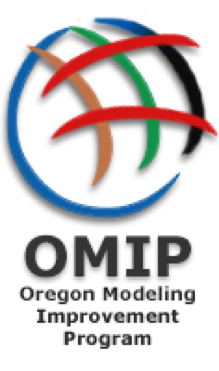-
Notifications
You must be signed in to change notification settings - Fork 5
Home

- SI - SWIM Inputs
- NED - New Economic Demographics
- ALD - Aggregate Land Development
- AA - Activity Allocation
- POPSIMSPG - PopulationSim Synthetic Population Generator
- PT - Person Transport
- CT - Commercial Transport
- TA - Traffic Assignment
- TR - Transit Assignment
- SL - Select Link
- SWIM VIZ - Reporting DB
- Swim Applications
- Helper Scripts
- SWIM small
- Building TLUMIP Java Programs
- Revising SWIM Zones
- Cost Inputs Overview
- Model Development Report
- September 2019 AA Code Deployment
- Labor Classification Script
Since the mid-1990s, ODOT has led the ground-breaking Transportation Land use Model Improvement Program (TLUMIP) with the help of a top notch consultant team and guidance from an internationally acclaimed Peer Review panel. The forward-looking TLUMIP program has spun off two land use models (PECAS and UrbanSim) and exercised one of the first tour-based simulation models (first use at a statewide level), among other innovations. The evolving statewide model has been used on many key state and regional policy studies in Oregon, The program’s contributions to national research & practice were evident in five Symposia over the years which brought together leading experts to share integrated modeling experience.
In the early 1990’s there was federal interest in developing tools that integrate land use, transportation, economics and the environment. The Federal Intermodal Surface Transportation Efficiency Act (ISTEA, 1991) and the 1990 Clean Air Act Amendments were enacted so local and state agencies could better coordinate land use and transportation decisions. In response, the level and type of analysis and information requested from modeling and analysis tools and methods changed nationally.

In response, ODOT formed the Oregon Modeling Improvement Program in 1994 to serve as a consensus forum and support group to coordinate land-use-transportation modeling efforts of federal, state, regional and local agencies. The Program includes three primary areas of focus:
- Collaboration: Bring together stakeholders and provide forums for exchange and new ideas. OMIP was implemented cooperatively, led by the Oregon Modeling Steering Committee, with membership and oversight from over 15 federal, state, and local agency and university partners. The OMSC serves as a collaborative and cooperative forum for transportation modeling. It provides peer review for models and model applications, pools resources for joint efforts, such as the 2009-2011 Oregon Household Activity Survey.
- Tools: Improve state-of-the-practice and promote state-of-the-art modeling in Oregon. New and expanded tools allow analysis of complex land use, transportation and economics relationships providing information for efficient and effective-decision making. Results need to be presented in a manner that can easily be understood by a wide variety of users. The Oregon Statewide Integrated Model (SWIM) was developed as part of this program. SWIM has included extensive technical review by national and international experts.
- Training: Formal education and training on the need for and application of these tools.
For more on OMIP see the OMIP website
ODOT Management and Staff
- Jerri Bohard, TDD Administrator
- Brian Dunn, TPAU Manager
- Becky Knudson, TPAU
- Alex Bettinardi, TPAU
Key Consulting Firms
- WSP/Parsons Brinckerhoff
- HBA Specto
- EcoNorthwest
- RSG
International Peer Panel
- Frank Koppelman, Northwestern University, Evanston, IL
- Keith Lawton, Keith Lawton Consulting, Newberg, Oregon
- Julie Dunbar, Dunbar Transportation Consulting, Bloomington, IL
- William Upton, Program Manager TLUMIP, retired
- David Simmonds, David Simmonds Consulting, Inc., Cambridge, England
- Michael Wegner, Spiekermann & Wegener, Dortmund, Germany
- Kim Fisher, National Center for Smart Growth, College Park, MD
A forecast model designed to represent the Oregon economy with respect to land-use and transportation by simulating the activity and market exchanges made by people and businesses. Household and business location decisions are simulated, as well as the travel generated by activities - such as commuting to work, purchasing commodities for industrial production and transporting final goods to markets within Oregon and outside of the state. It is designed for statewide and regional long range transportation planning and policy analysis. Information from SWIM is also designed to inform other modeling tools, such as metropolitan planning organization travel models, freight models, and regional studies.
SWIM is described as an “integrated” model because the sub-models are interconnected. Information is shared back and forth between the sub-models, mimicking the behaviors observed in the real world where people and businesses share information and exchange goods & services based on prices and location. The integrated modular design better represents real-world conditions and activity, but requires immense amounts of data, significant development time, powerful computing capabilities and trained staff. As such, few states have similar models.

Why is it important… SWIM is designed to serve as a testing ground to evaluate “what if” scenarios related to:
- areas we can control, such as public policy related to taxes, fees and land use rules;
- areas we cannot control such as rising oil prices, national recessions, and population growth; and
- other issues impacting decisions related to the Oregon transportation system.
How has it been used… SWIM has been used for a variety of key state and regional studies in Oregon. See the Applications page in the appendix for specific details.
SWIM-TLUMIP Model User Guide, version 2.5
- SI - SWIM Inputs
- NED - New Economic Demographics
- ALD - Aggregate Land Development
- AA - Activity Allocation
- POPSIMSPG - PopulationSim Synthetic Population Generator
- PT - Person Transport
- CT - Commercial Transport
- TA - Traffic Assignment
- TR - Transit Assignment
- SL - Select Link
- SWIM VIZ - Reporting DB